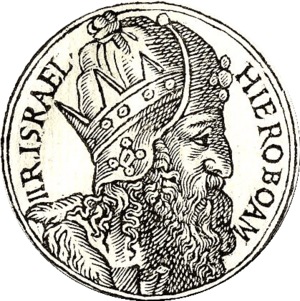Jeroboam II facts for kids
Quick facts for kids Jeroboam II |
|
|---|---|

Jeroboam II from Guillaume Rouillé's Promptuarii Iconum Insigniorum
|
|
| King of Northern Israel | |
| Reign | 793–753 BC or 786–746 BC |
| Predecessor | Jehoash |
| Successor | Zechariah |
| Father | Jehoash |
Jeroboam II was an important king of the ancient Kingdom of Israel. He was the son of Jehoash and became the thirteenth king of the northern kingdom. Jeroboam II ruled for about forty-one years in the 8th century BC. During his time, Amaziah and Uzziah were kings in the southern Kingdom of Judah.
Contents
A Time of Power and Growth
Jeroboam II's reign is often seen as a very successful period for the Kingdom of Israel. Historians like William F. Albright suggest he ruled from 786 to 746 BC. Other experts, like E. R. Thiele, say he ruled from 782 to 753 BC, after a time sharing power with his father.
Military Victories and Expanded Land
King Jeroboam II was a strong military leader. He won important battles against the Arameans, who were a neighboring people. He even managed to capture Damascus, a major city. These victories helped Israel grow its territory back to its earlier, larger size. It stretched from a place called Hamath all the way to the sea.
What Did Archaeologists Find?
In 1910, a researcher named G. A. Reisner found many pieces of pottery with writing on them. These were discovered at the royal palace in Samaria, which was Israel's capital. These written pieces, called ostraca, were from Jeroboam II's time. They tell us about how the kingdom was run and even about the language and religion of the period. More recently, in 2020, a special clay seal belonging to one of Jeroboam II's servants was also confirmed as real.
A Prosperous Kingdom
Archaeological discoveries show that Jeroboam II's reign was the richest time the northern kingdom of Israel had ever known. By the late 8th century BC, Israel was very crowded, with about 350,000 people living there. This wealth came from trading things like olive oil, wine, and possibly horses. They traded with Egypt and especially with Assyria, a powerful empire.
However, this wealth also brought problems. The prophet Amos said that the king's successes made people too proud. Rich people were taking advantage of the poor. There was a lot of luxury in palaces, and people cared mostly about having fun.
Religious Practices and Prophets
During Jeroboam II's rule, people worshipped the God of Israel at places like Dan and Beth-el. They used statues, such as the golden calf, in their worship. These religious services, along with other foreign religions, made the prophets very upset.
This was the time of important prophets like Hosea, Joel, Amos, and Jonah. They all spoke out against the greed and selfishness they saw among Israel's wealthy people. They criticized those who "lie upon beds of ivory" and "eat lambs from the flock." The Book of Kings in the Bible says Jeroboam did "evil in the eyes of the Lord." This was because he allowed the poor to be treated badly and kept supporting the worship centers at Dan and Bethel, instead of the temple in Jerusalem.
The Great Earthquake Around 760 BC
The Book of Amos mentions a very large earthquake that happened around 760 BC. This earthquake might have occurred near the end of Jeroboam II's rule. Geologists and archaeologists have found evidence of this huge earthquake in different places across Israel and Jordan. For example, at Tel Hazor and Lachish, scientists found signs of sudden destruction from around 760 BC.
Some experts believe this earthquake was incredibly powerful, possibly as strong as magnitude 7.8 or even 8.2. It might have been the biggest earthquake on the Dead Sea fault line in 4,000 years. The center of the earthquake could have been 200–300 kilometers north of modern-day Israel. Besides Amos, the Bible also mentions this earthquake in Zechariah 14:5. Recent digs at ancient Gath have also shown signs of this major earthquake.
Jeroboam II in the Bible
You can find Jeroboam II mentioned in the Old Testament in the books of 2 Kings, 1 Chronicles, Hosea, and Amos. It's important not to confuse him with Jeroboam I, who was a different king.
See also
 In Spanish: Jeroboam II para niños
In Spanish: Jeroboam II para niños
- 2 Kings 14
- 2 Kings 15
- Omrides, the previous dynasty

